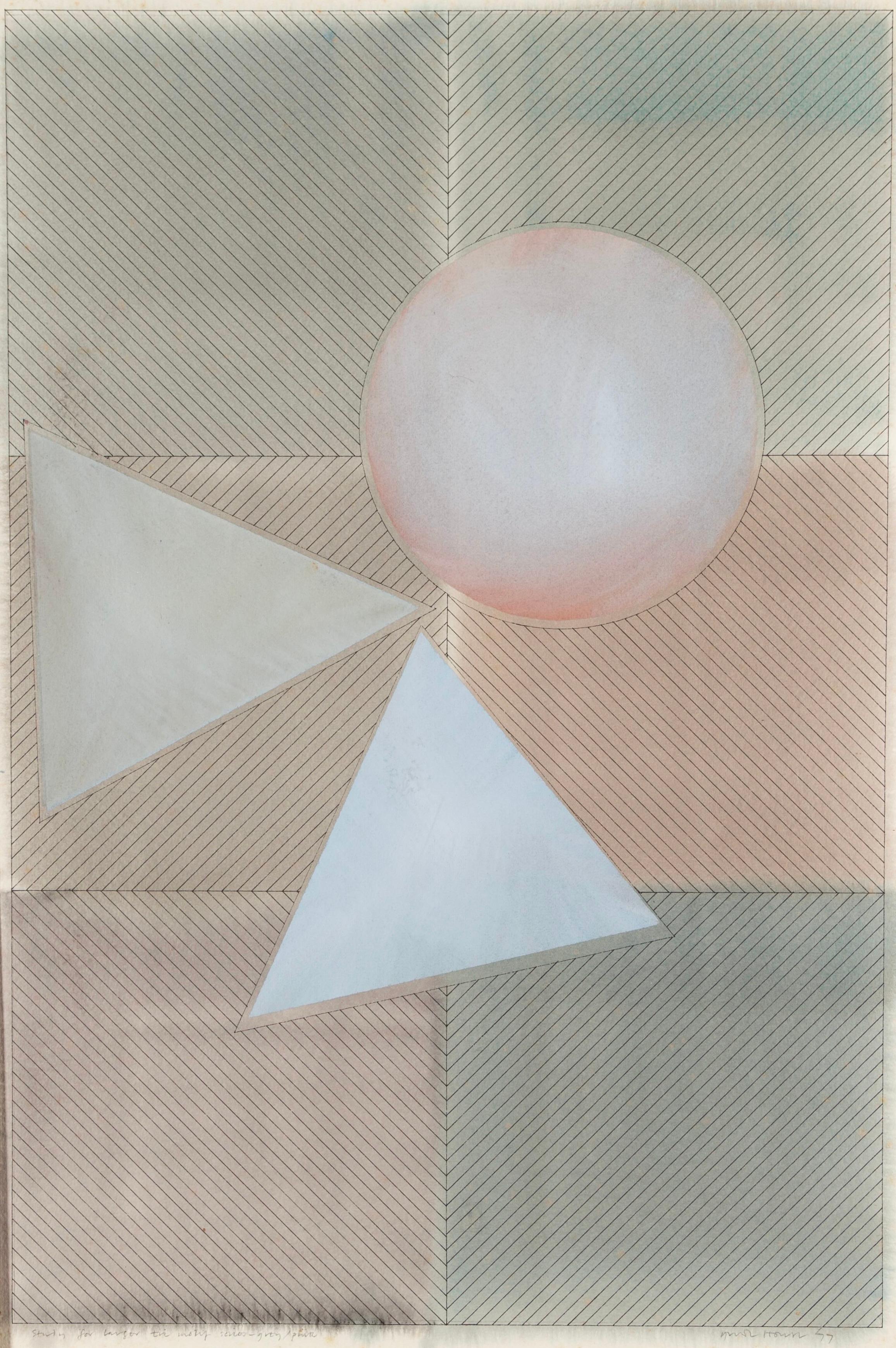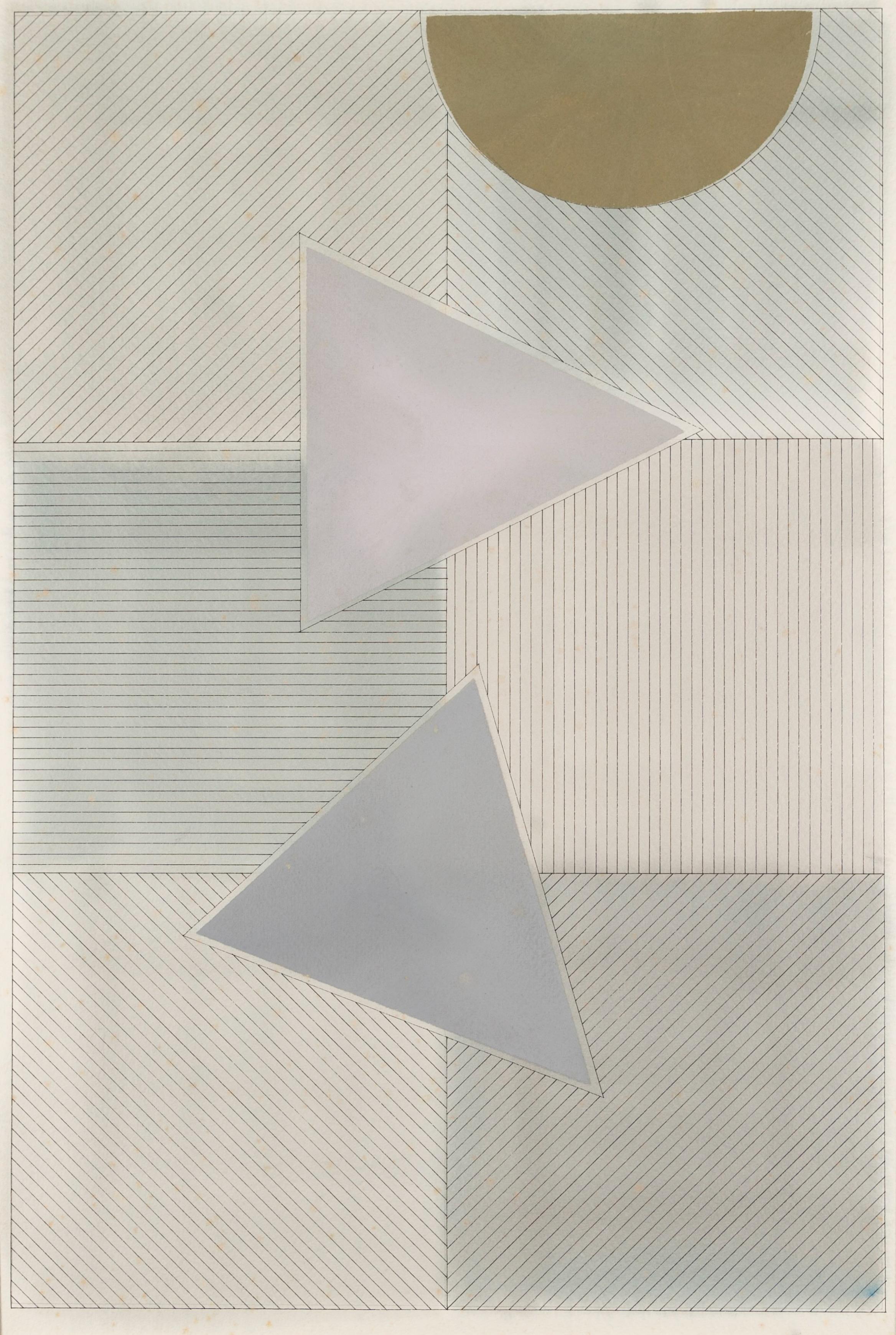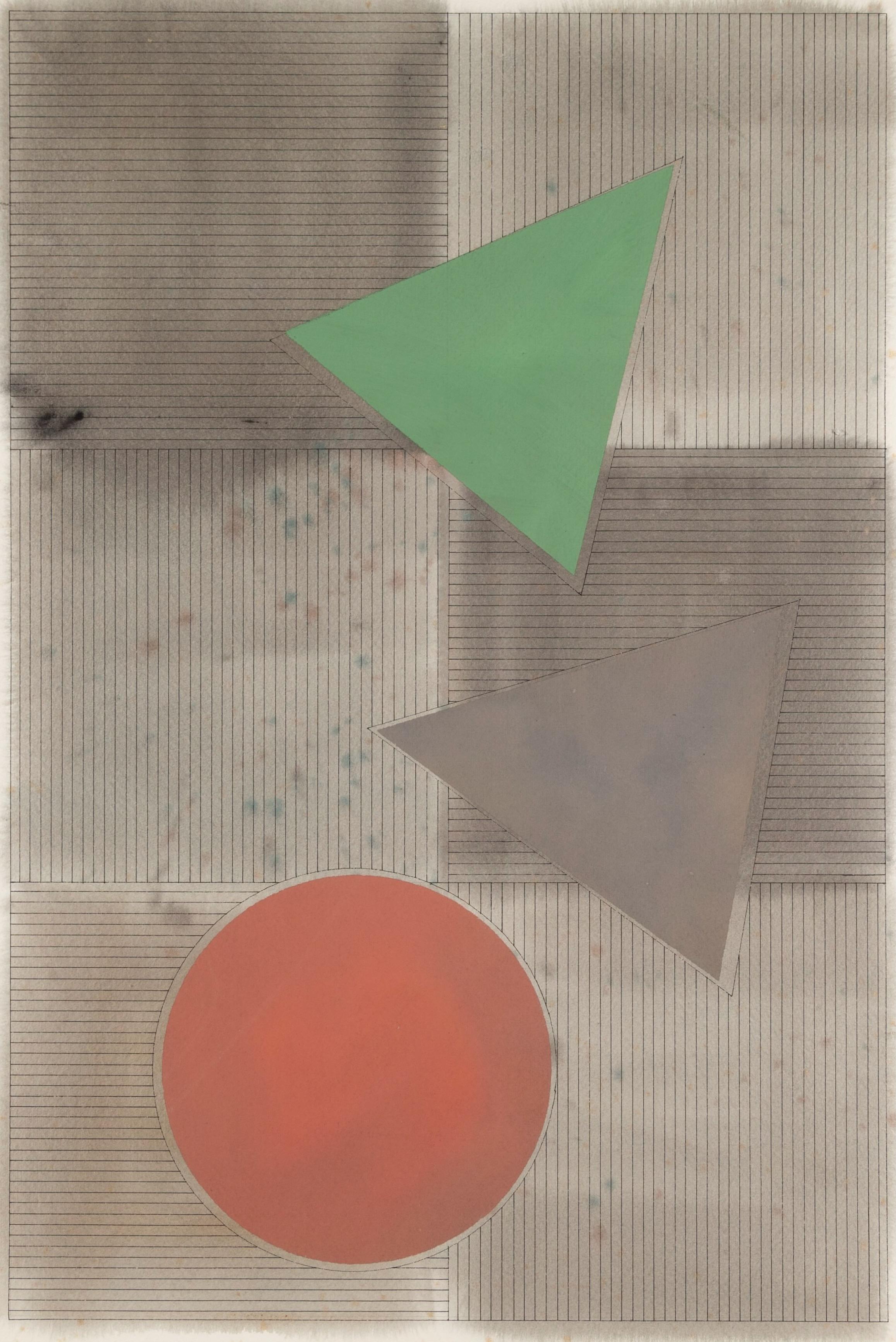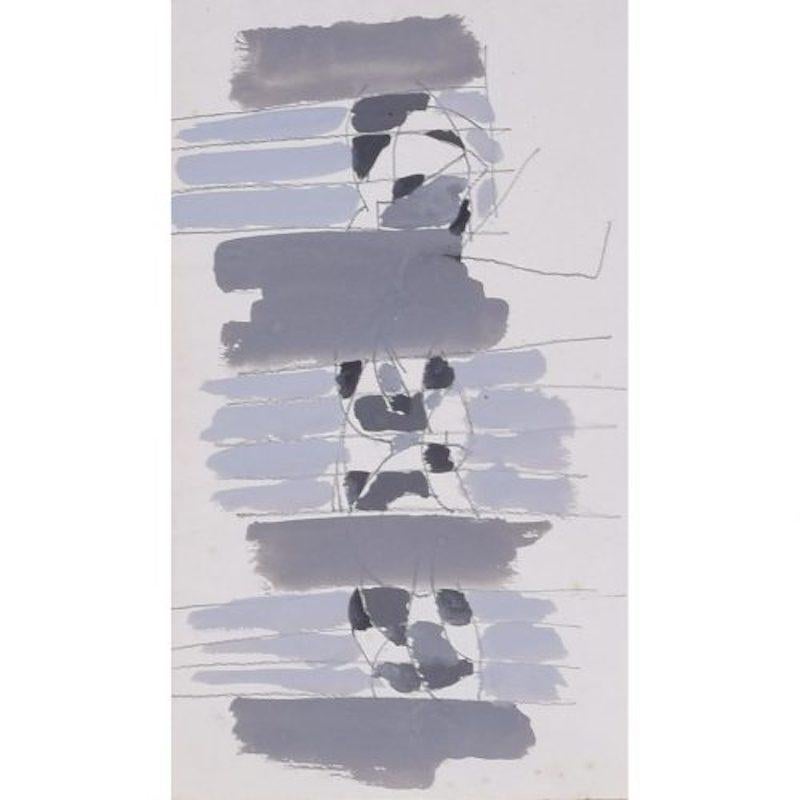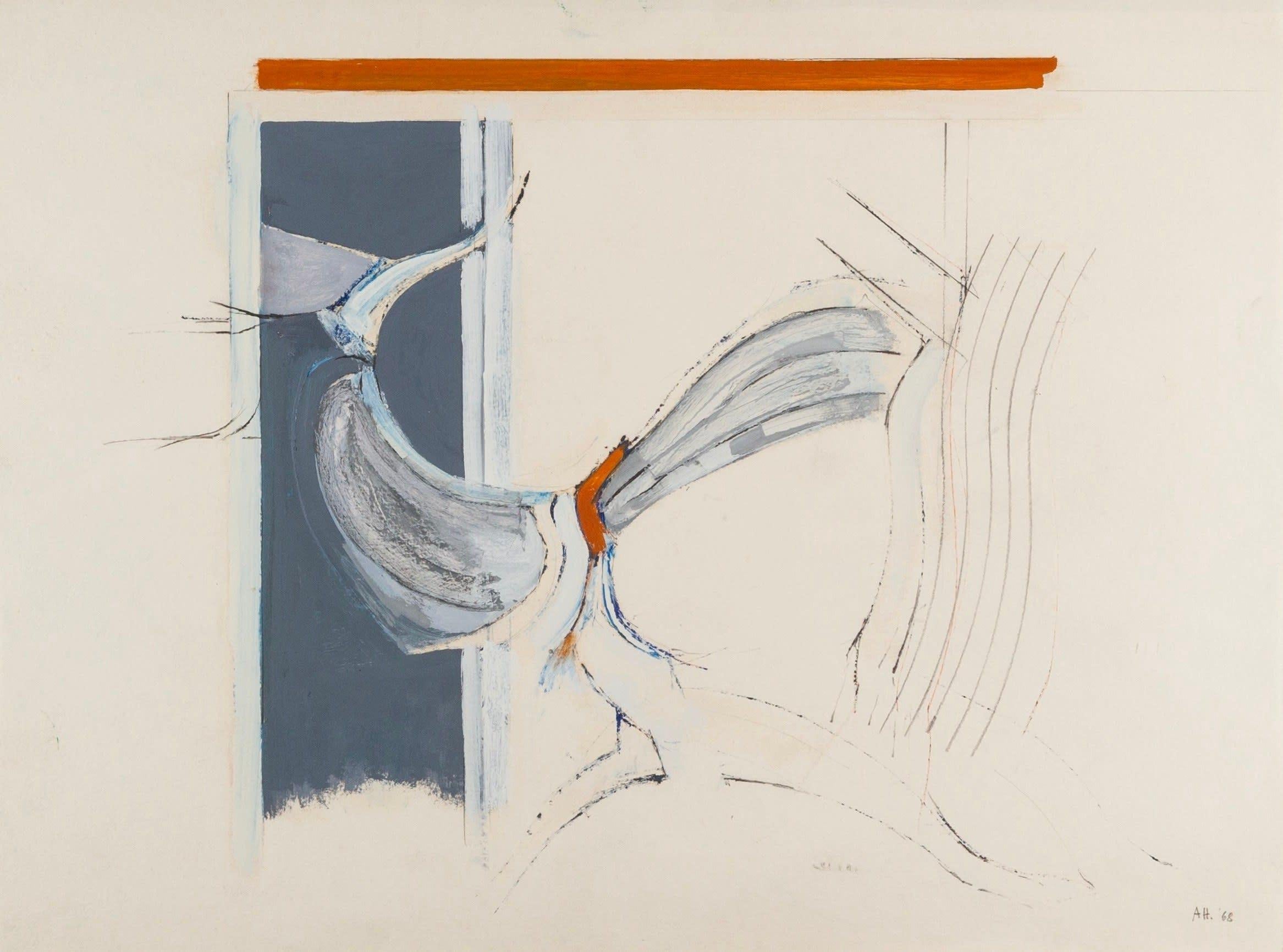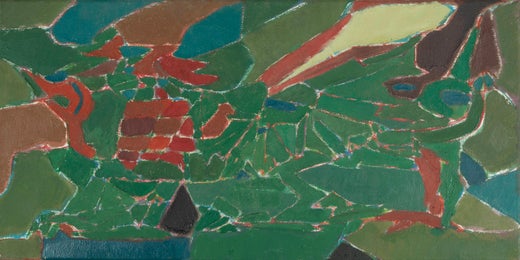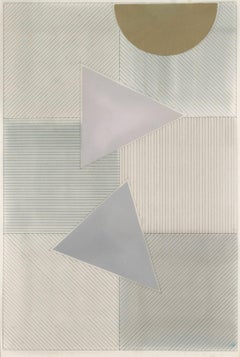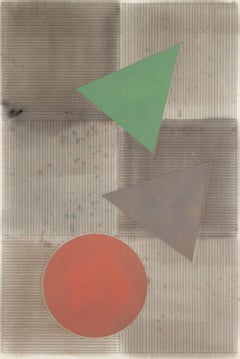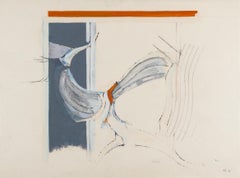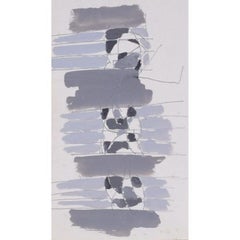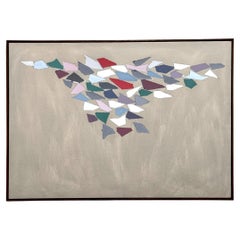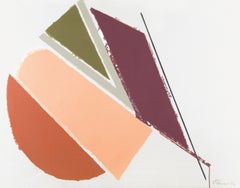Items Similar to Grey, from Study for Larger Tri Motif Series, c. 1977 - Gouache and Watercolour
Want more images or videos?
Request additional images or videos from the seller
1 of 6
Gordon HouseGrey, from Study for Larger Tri Motif Series, c. 1977 - Gouache and Watercolour1977 circa
1977 circa
$7,343.74
£5,500
€6,364.37
CA$10,347.65
A$11,393.76
CHF 5,908.16
MX$134,933.45
NOK 75,000.35
SEK 70,096.32
DKK 47,534.31
About the Item
Gordon House was born in 1932 in Pontardawe, South Wales. Early exposure to art on trips to the Glynn Vivian Art Gallery as a young boy inspired House towards creative endeavors and at the age of fourteen he was awarded a grant to enter art school which he accepted. From 1947 to 1950 he studied at Luton School of Art, Bedfordshire, and St. Albans School of Art, Hertfordshire. House's contemporaries included Richard Smith and John Plumb with whom he remained close. During the early fifties, after finishing art school, House began work as assistant to the ecclesiastical sculptor Theodore Kern. He also spent time at an advertising studio where he honed his burgeoning skills in typography and graphic design. In 1952 House was offered the position of designer for Imperial Chemical Industries Plastics Division where he stayed until 1959. This was followed by two years spent as graphic designer for the Kynoch Press in London. In 1961 House set out on his own as a self-employed designer and typographer. Initially this was supplemented by part-time teaching at art schools in and around London but by 1964 House was able to devote himself entirely to his design work which freed up valuable time to concentrate on his own artistic output in the studio.
In the late fifties, informed by the new art emerging from America and that of his contemporaries in England, House began to create large-scale abstract works which he was invited to show in 1959 at Dennis Bowen's legendary New Vision Centre in Marble Arch.
House was an active participant in the vibrant London art scene of the sixties, regularly attending lectures, exhibitions and discussions. In 1960 he exhibited in 'Situation' the key abstract exhibition of the decade held at the RBA Galleries. Other participating artists included Robyn Denny, Bernard and Harold Cohen, Gillian Ayres, John Hoyland, Richard Smith and William Turnbull among others. These artists, united by a common admiration for American Abstract Expressionism, were frustrated by the lack of exposure given to large-scale abstract works in commercial galleries so they organised their own exhibition. The name was derived from the participants' idea that an abstract painting that occupied the whole field of vision would involve the spectator in an 'event' or 'situation'. This exhibition was followed by 'New London Situation' in 1961 and a nationwide touring Arts Council presentation in recognition of the significance of the two earlier shows.
In 1961 House began producing his first prints at the Kelpra Studio, run by Chris and Rose Prater, where he made the earliest fine art screenprint ever to be produced in Britain. Artists such as Paolozzi and Hamilton followed in his footsteps and together they started a printmaking revolution in Britain. They cemented the medium of the screenprint in the world of fine art as opposed to the commercial sphere and secured the reputation of Kelpra in the process. Later, together with Cliff White, House set up the White Ink (Ltd.) print studio in London, where he produced etchings and wood engravings on a series of magnificent antique printing presses he had collected. White Ink soon gained a reputation for innovative and high quality printmaking, attracting artists such as R. B. Kitaj, Richard Smith, Joe Tilson, Sidney Nolan, Victor Pasmore, Eduardo Paolozzi, Bernard Cohen and Elizabeth Frink.
Printmaking was to remain a key part of House's oeuvre throughout the rest of his career, whether in the medium of screenprint, etching, woodcut, linocut or lithograph. In 1981 a retrospective exhibition of his graphic works opened at the Carnegie Institute, Pittsburgh, and in 1982 this travelled to the Brooklyn Museum, New York. These shows were instrumental in bringing House's prints to the attention of a wider American audience.
- Creator:Gordon House (1932, British)
- Creation Year:1977 circa
- Dimensions:Height: 30.01 in (76.2 cm)Width: 22.49 in (57.1 cm)
- Medium:
- Period:
- Condition:
- Gallery Location:Kingsclere, GB
- Reference Number:1stDibs: LU2718215410712
Gordon House
The Guardian wrote of Gordon House, upon his death in 2004: Many of the works made during his last years by the painter and graphic designer Gordon House, who has died aged 71, referred back to his birthplace in the Swansea valley. He spent his earliest years in the steel town of Pontardawe. In Tin-pan Valley, the memoir he published earlier this year, he recalled "the clamour of steel mills ... the tinplate works and pithead gear" and "dynamite blasting as coal seams were struck higher up the valley". Unemployment and the depression of the 1930s led Gordon's parents to take him from the valleys of south Wales to the order and designed coherence of Letchworth, "Hertfordshire's first garden city". After leaving school at 14, he went to study, first, at Luton School of Art. For a while after that, he worked in a hospital, before, with the aid of a scholarship, moving on to St Albans School of Art. By 1961, Gordon had become established among a new generation of artists as an independently minded and adventurous painter and designer. The previous year, he had shown his large, bold, hard-edged canvasses at the important London "Situation" exhibition of large-scale abstract painting, and had designed the catalogue for that exhibition. As the 1960s moved on, Gordon designed for the pop world. He worked for the Beatles, designing their White album and the back of the Sergeant Pepper album, for which his longtime friend Peter Blake designed the front. Later, he designed Wings' first album. He delighted in the creative energy of others, and so could respond to the talents of musicians and artists alike. Gordon made paintings throughout his life as a designer. During the 1960s and 70s, his canvasses and prints reflected the dramatic tensions of his graphic design; by the 1980s, Wales had become his constant subject matter. The surface, texture and colour of his paintings softened. No doubt, he needed to pay homage to the places and the people who had shaped him, just as he always paid homage to the artists for whom he designed. His canvasses reduced in size, becoming palm-of-the-hand landscapes. He spent much time in Wales and, in his final years, he used his brush to walk a path through memories of collieries, valleys, smoking stacks, rows of cottages and the people who had first nurtured him.
About the Seller
No Reviews Yet
Vetted Professional Seller
Every seller passes strict standards for authenticity and reliability
Established in 2010
1stDibs seller since 2024
43 sales on 1stDibs
Typical response time: 8 hours
- ShippingRetrieving quote...Shipping from: Kingsclere, United Kingdom
- Return Policy
More From This Seller
View AllGrey/Pink, from Study for Larger Tri Motif Series, 1977 - Gouache, Watercolour
By Gordon House
Located in Kingsclere, GB
Gordon House was born in 1932 in Pontardawe, South Wales. Early exposure to art on trips to the Glynn Vivian Art Gallery as a young boy inspired House towards creative endeavors and ...
Category
20th Century Abstract Paintings
Materials
Ink, Watercolor, Gouache
Ochre, from Study for Larger Tri Motif Series, 1977 - Pale Colours
By Gordon House
Located in Kingsclere, GB
Gordon House was born in 1932 in Pontardawe, South Wales. Early exposure to art on trips to the Glynn Vivian Art Gallery as a young boy inspired House towards creative endeavors and ...
Category
1970s Abstract Paintings
Materials
Ink, Watercolor, Gouache
Red/Green, from Study for Larger Tri Motif Series, 1977 - Gouache, Watercolour
By Gordon House
Located in Kingsclere, GB
Gordon House was born in 1932 in Pontardawe, South Wales. Early exposure to art on trips to the Glynn Vivian Art Gallery as a young boy inspired House towards creative endeavors and at the age of fourteen he was awarded a grant to enter art school which he accepted. From 1947 to 1950 he studied at Luton School of Art, Bedfordshire, and St. Albans School of Art, Hertfordshire. House's contemporaries included Richard Smith and John Plumb with whom he remained close. During the early fifties, after finishing art school, House began work as assistant to the ecclesiastical sculptor Theodore Kern. He also spent time at an advertising studio where he honed his burgeoning skills in typography and graphic design. In 1952 House was offered the position of designer for Imperial Chemical Industries Plastics Division where he stayed until 1959. This was followed by two years spent as graphic designer for the Kynoch Press in London. In 1961 House set out on his own as a self-employed designer and typographer. Initially this was supplemented by part-time teaching at art schools in and around London but by 1964 House was able to devote himself entirely to his design work which freed up valuable time to concentrate on his own artistic output in the studio.
In the late fifties, informed by the new art emerging from America and that of his contemporaries in England, House began to create large-scale abstract works which he was invited to show in 1959 at Dennis Bowen's legendary New Vision Centre in Marble Arch.
House was an active participant in the vibrant London art scene of the sixties, regularly attending lectures, exhibitions and discussions. In 1960 he exhibited in 'Situation' the key abstract exhibition of the decade held at the RBA Galleries. Other participating artists included Robyn Denny, Bernard and Harold Cohen, Gillian Ayres, John Hoyland, Richard Smith and William Turnbull among others. These artists, united by a common admiration for American Abstract Expressionism, were frustrated by the lack of exposure given to large-scale abstract works in commercial galleries so they organised their own exhibition. The name was derived from the participants' idea that an abstract painting that occupied the whole field of vision would involve the spectator in an 'event' or 'situation'. This exhibition was followed by 'New London Situation' in 1961 and a nationwide touring Arts Council presentation in recognition of the significance of the two earlier shows.
In 1961 House began producing his first prints at the Kelpra Studio, run by Chris and Rose Prater, where he made the earliest fine art screenprint ever to be produced in Britain. Artists such as Paolozzi and Hamilton followed in his footsteps and together they started a printmaking revolution in Britain. They cemented the medium of the screenprint in the world of fine art as opposed to the commercial sphere and secured the reputation of Kelpra in the process. Later, together with Cliff White, House set up the White Ink (Ltd.) print studio in London, where he produced etchings and wood engravings on a series of magnificent antique printing presses...
Category
20th Century Abstract Paintings
Materials
Ink, Watercolor, Gouache
Untitled, Oil and Pencil Painting by Adrian Heath, 1968
By Adrian Heath
Located in Kingsclere, GB
Untitled, Oil and Pencil Painting by Adrian Heath 1920-1992, 1968
Additional information:
Medium: Oil and pencil
56 x 76.5 cm
22 x 30 1/8 in
Signed with initials and dated
Category
20th Century Abstract Paintings
Materials
Pencil
Untitled, Gouache & Watercolour on Paper Painting by Martin Bradley, 1962
By Martin Bradley
Located in Kingsclere, GB
Untitled, Gouache & Watercolour on Paper Painting by Martin Bradley, 1962
Additional information:
Medium: Gouache and watercolour on paper
65.3 x 88.9 cm
25 3/4 x 35 in
Martin Brad...
Category
20th Century Abstract Drawings and Watercolors
Materials
Watercolor
III, from Tri Motifs, 1977 - Bold Shapes, Orange, Green, Gouache and Watercolour
By Gordon House
Located in Kingsclere, GB
Gordon House was born in 1932 in Pontardawe, South Wales. Early exposure to art on trips to the Glynn Vivian Art Gallery as a young boy inspired House towards creative endeavors and ...
Category
20th Century Abstract Paintings
Materials
Ink, Watercolor, Gouache
You May Also Like
Clifford Ellis, 'Abstract in Grey II' midcentury gouache painting
By Clifford Ellis
Located in London, GB
We acquired a series of paintings, photographs and posters from Clifford and Rosemary Ellis's studio. To find more scroll down to "More fro...
Category
Mid-20th Century Abstract Abstract Paintings
Materials
Gouache
Untitled, 1980, gouache on paper
Located in PARIS, FR
Andrée HONOREE (1945-1992)
Untitled, 1980
Gouache on paper
Signed and dated "1980" lower center
43 x 31.5 cm
Born in 1945 in Tourcoing, Andrée Honoré is one of the women sculptors who have chosen wood as their main medium. For a time, she had a studio in the Passage Ricaut in the 13th arrondissement of Paris, where she worked alongside the artists Jacques Hérold (1901-1987), Edgard Pillet...
Category
1980s Abstract Abstract Drawings and Watercolors
Materials
Gouache
$734 Sale Price
20% Off
Robert Goodnough 'Larger Shapes Gray', 1980
By Robert Goodnough
Located in Dallas, TX
Robert Goodnough (American, 1917-2010) begun his career as a figurative painter but after moving to NYC in 1951 and seeing the work of the early Abstract Expressionists he left repre...
Category
Vintage 1980s Paintings
Materials
Canvas, Acrylic, Paint
Yond (geometric, pastel, acrylic on paper painting)
By Carole Eisner
Located in New York, NY
Artist Bio:
Carole Eisner was born and raised in New York City and received a BFA from Syracuse University. She has had eight solo shows in New York City at David Findlay Gallery, E...
Category
1980s Paintings
Materials
Linen, Acrylic
$9,200 Sale Price
20% Off
Hiroshi Murata, Acrylic on Canvas, dtd. 1973, 50.25" x 60.25"
Located in Dallas, TX
Introduce an unparalleled piece of mid-century modern elegance to your art collection with Hiroshi Murata's Acrylic on Canvas, dated 1973. Measuring at 50.25" x 60.25", this exquisit...
Category
20th Century American Mid-Century Modern Contemporary Art
Materials
Canvas, Paint
Greg Parker, Untitled, 1988; Graphite and Oil on Gessoed Panel
By Greg Parker
Located in Chicago, IL
Greg Parker, American, b. 1952
Untitled, 1988
Graphite and oil on gessoed panel
Signed and dated to verso. Geometric composition in monochromatic variations ending on a graphite...
Category
Vintage 1980s American Modern Paintings
Materials
Gesso, Paint
More Ways To Browse
Paolozzi Eduardo
R B Kitaj
John Smith Vintage
Gillian Ayres
Vintage House Keys
Cliff House
Sidney Nolan
Large British Landscape Oil Paintings
Dutch Still Life
Old Masters Landscape
Reclining Nude
Vintage Oil Still Life Flowers
Impressionist Boat Oil
Early 20th Century Realism Paintings
Oil Still Life Florals
American Scene Paintings
Waves Crashing
Art By Indian Artists
